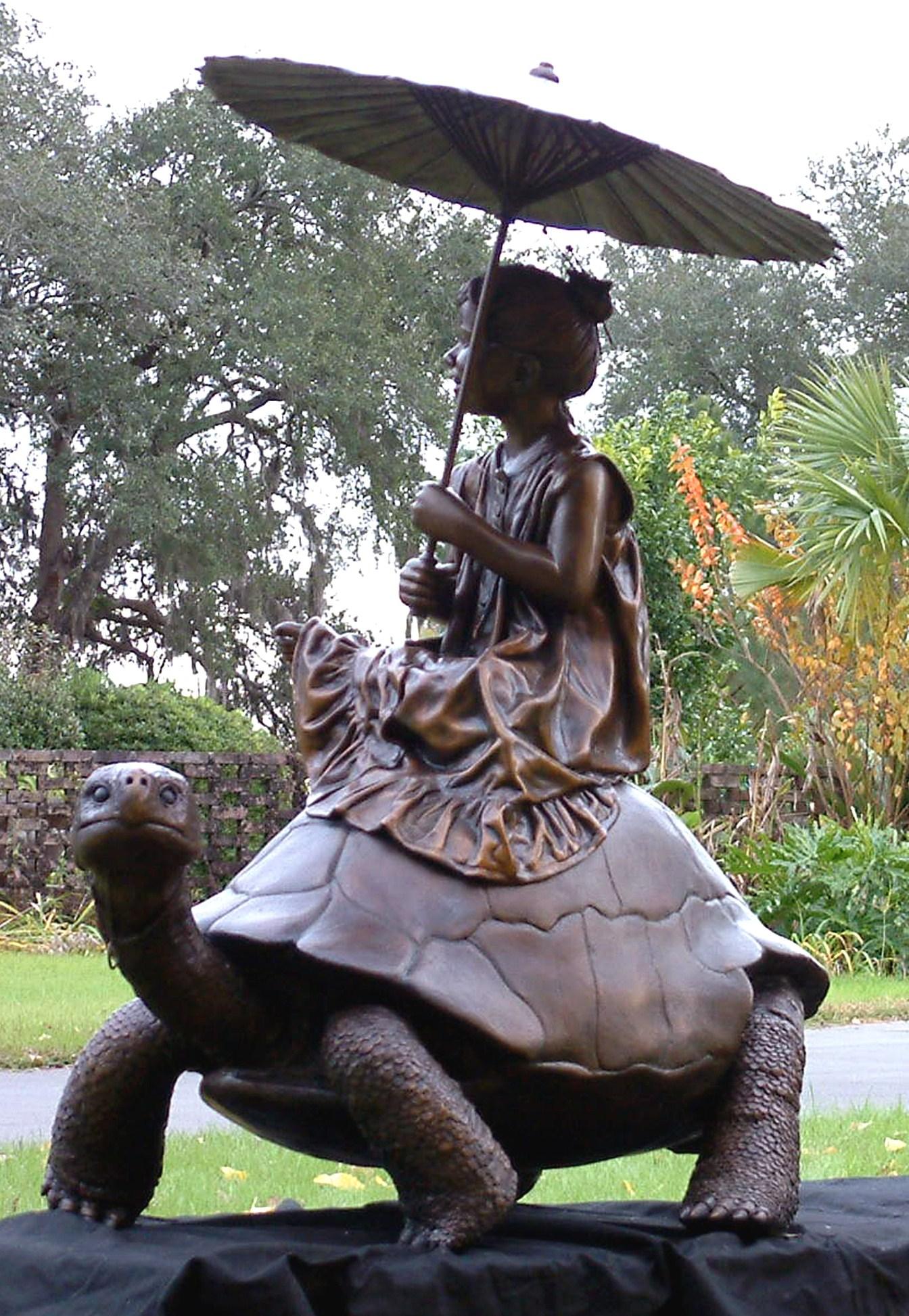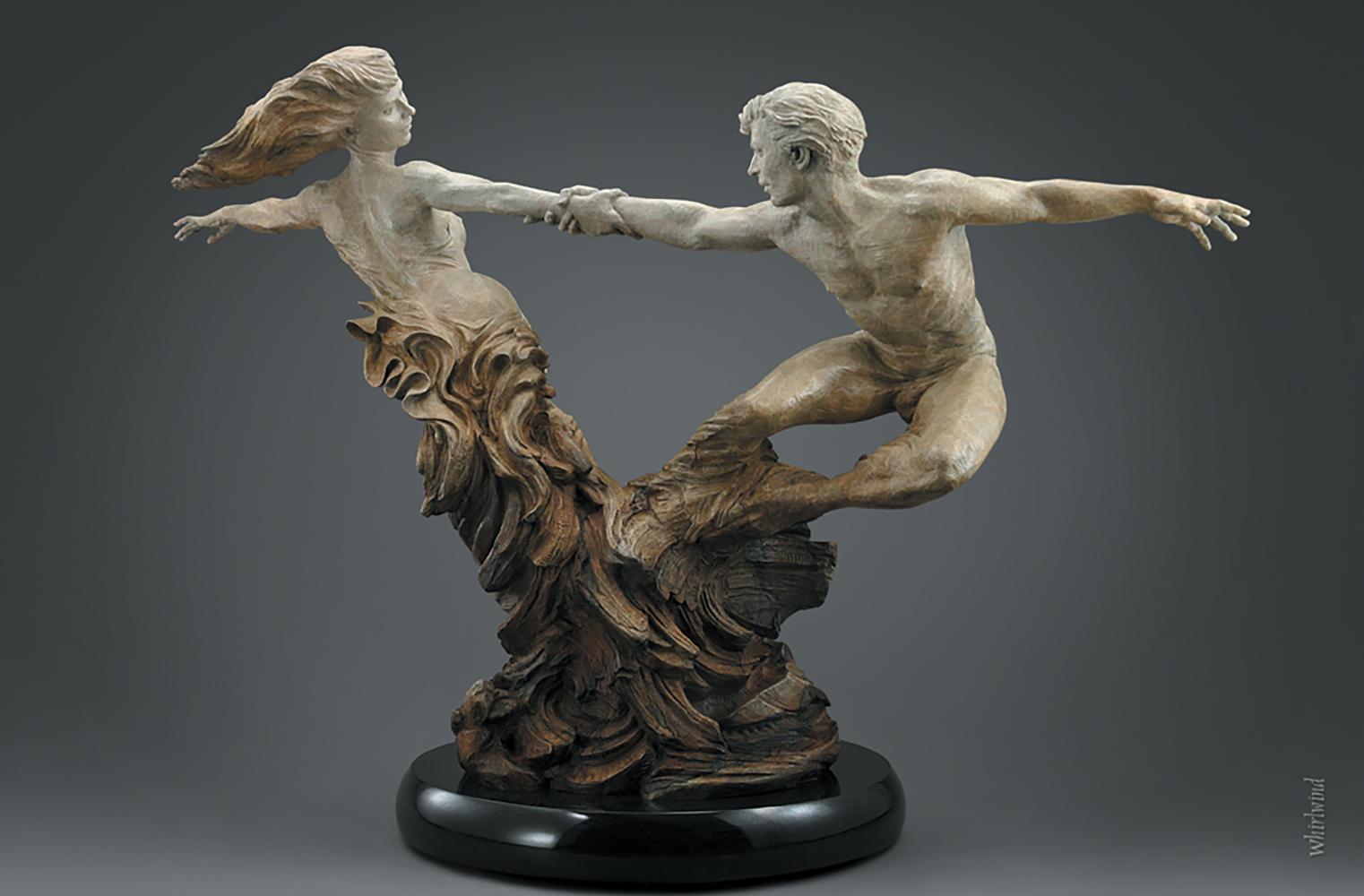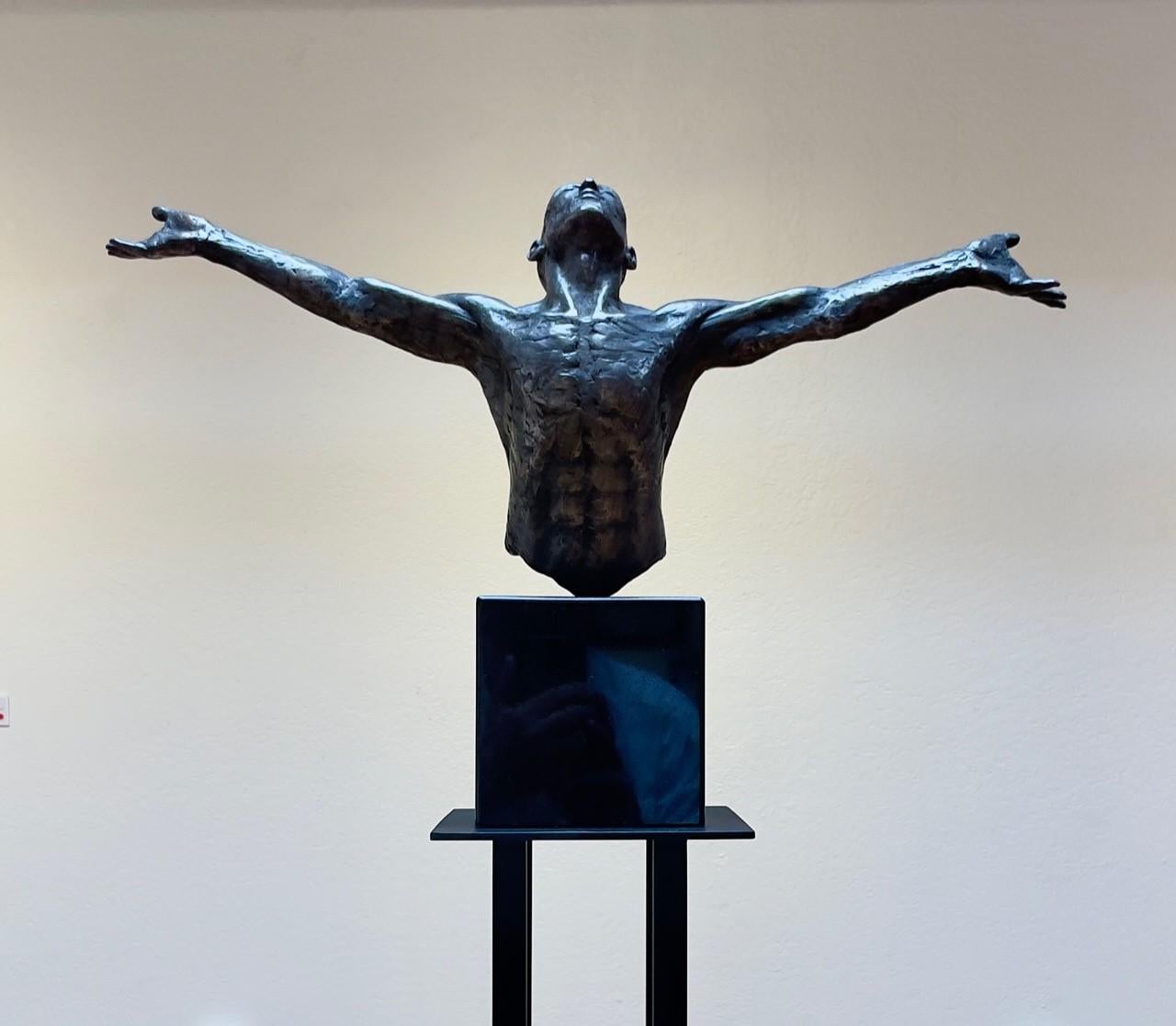Carl KaubaNative American in Canoec. 1920
c. 1920
About the Item
- Creator:Carl Kauba (1865 - 1922, Austrian)
- Creation Year:c. 1920
- Dimensions:Height: 5.5 in (13.97 cm)Width: 10 in (25.4 cm)Depth: 2.75 in (6.99 cm)
- Medium:
- Movement & Style:
- Period:
- Condition:
- Gallery Location:Missouri, MO
- Reference Number:1stDibs: LU74733374281
Carl Kauba
Austrian sculptor Carl Kauba was fascinated by the American West, creating dynamic cast bronze sculptures of cowboys, Native Americans and buffalo. Between 1895 and 1912, his polychrome pieces captured the attention of an American audience, while his domestic statutory work in Austria helped solidify his artistic reputation.
He was born the son of a shoemaker in 1865 in Vienna, Austria. He later studied at the Academy of Fine Arts in Vienna before learning from sculptor Karl Waschmann and sculptor and medallist Stefan Schwartz.
Although some accounts have Kauba traveling to the United States to create models and sketches, scholars have questioned the inaccuracies in his work’s weapon detailing and equestrian costumes. Kauba loved the Western tales of German author Karl May and was known to have a friend in Ohio who mailed him costume material, all of which may have provided his references for art.
Kauba’s bronze work is recognized as exceptional Viennese craftsmanship imbued with artistic intricacies and realism. His sculptures of cavalrymen, cowboys and Indigenous people from the American West put him in the same category as titans of American Western art like Frederic Remington and Charles Marion Russell.
Original Carl Kauba art experienced a resurgence in popularity during a 1950s advertising campaign for Latendorfer in New York. His works have remained prized by Wild West collectors everywhere.
Kauba’s art has been exhibited at many American art galleries, including the Thomas Nygard Gallery in Montana and the Ophir Gallery in New Jersey.
On 1stDibs, find a collection of Carl Kauba decorative objects, collectibles and more.
- ShippingRetrieving quote...Ships From: Missouri, MO
- Return PolicyA return for this item may be initiated within 2 days of delivery.
- Study AimBy Carl KaubaLocated in Missouri, MOCarl Kauba "Study Aim" c. 1920 Bronze with Brown Patina Signed approx. 9.5 x 10 x 4 This Austrian sculptor was born in Vienna in 1865. His teachers were Karl Waschmann (1848-1905), known for his ivory sculptures and portrait plaquettes of contemporary celebrities, and Stefan Schwartz (1851-1924), who exhibited in Paris, including the Exposition Universelle of 1900 where he won a gold medal. Kauba's intricate bronzes, imported to the United States between 1895 and 1912, were cast at the Roman Bronze Works. Kauba was part of the nineteenth-century tradition of polychrome bronze sculpture. There were several types of patinas on a single statue: he could render the color of buckskin, variously tinted shirts, blankets, feathers, as well as beaded moccasins. Reportedly, Kauba came to America around 1886. Inspired by the Western tales of German author Karl May, he traveled to the West and made sketches and models. Critics, however, pointed out inaccuracies of costume and other details. For instance, the guns that his "mid-nineteenth-century" figures use are models produced after 1898. Apparently he did all of his works back in Vienna. Besides the variety of color, Kauba's bronzes show a great range of textures and his style is highly naturalistic. The sculptor loved ornament, some of which he rendered with coiled wire for reins, rope and feathers in headdresses. He successfully rendered figures in motion and often executed compositions with more than one figure. Berman (1974) illustrates non-Western subjects by Kaula, such as the pendants Where? and There (ca. 1910), a seated Scottish couple, impressive in the expressions and the details on patterned fabrics of both sitters. Another genre piece is Buster Brown...Category
Early 20th Century Realist Figurative Sculptures
MaterialsBronze
- Going into BattleBy Carl KaubaLocated in Missouri, MOCarl Kauba "Going into Battle" c. 1920s Bronze with Brown Patina Signed approx 10 x 10 x 4 (including wooden base) This Austrian sculptor was born in Vienna in 1865. His teachers were Karl Waschmann (1848-1905), known for his ivory sculptures and portrait plaquettes of contemporary celebrities, and Stefan Schwartz (1851-1924), who exhibited in Paris, including the Exposition Universelle of 1900 where he won a gold medal. Kauba's intricate bronzes, imported to the United States between 1895 and 1912, were cast at the Roman Bronze Works. Kauba was part of the nineteenth-century tradition of polychrome bronze sculpture. There were several types of patinas on a single statue: he could render the color of buckskin, variously tinted shirts, blankets, feathers, as well as beaded moccasins. Reportedly, Kauba came to America around 1886. Inspired by the Western tales of German author Karl May, he traveled to the West and made sketches and models. Critics, however, pointed out inaccuracies of costume and other details. For instance, the guns that his "mid-nineteenth-century" figures use are models produced after 1898. Apparently he did all of his works back in Vienna. Besides the variety of color, Kauba's bronzes show a great range of textures and his style is highly naturalistic. The sculptor loved ornament, some of which he rendered with coiled wire for reins, rope and feathers in headdresses. He successfully rendered figures in motion and often executed compositions with more than one figure. Berman (1974) illustrates non-Western subjects by Kaula, such as the pendants Where? and There (ca. 1910), a seated Scottish couple, impressive in the expressions and the details on patterned fabrics of both sitters. Another genre piece is Buster Brown...Category
Early 20th Century Realist Figurative Sculptures
MaterialsBronze
- Mountain GoatBy Jules MoigniezLocated in Missouri, MOJules Moigniez "Mountain Goat" Bronze approx 11 x 9 x 4 inches Signed Jules Moigniez (1835-1894) Jules Moigniez was born in Senlis sur L'Oise, France ...Category
1870s Realist Figurative Sculptures
MaterialsBronze
- Chien Braque (Tom)By Pierre Jules MêneLocated in Missouri, MOPierre Jules Mene "Chien Braque" (Tom) Bronze approx. 5 x 9 x 4.25 Signed PIERRE JULES MENE (1810-1879) Pierre Jules Mene, (P. J. Mene), was born in Pa...Category
1860s Realist Figurative Sculptures
MaterialsBronze
- The Hunter and HoundBy Pierre Jules MêneLocated in Missouri, MOPierre-Jules Mene "The Hunter and Hound" (Le Valet de Limier) 1879 Bronze approx. 19 x 8 x 14 inches Signed PIERRE JULES MENE (1810-1879) Pierre...Category
1870s Realist Figurative Sculptures
MaterialsBronze
- Little Red Riding Hood InkwellBy Antoine BofillLocated in Missouri, MOAntoine Bofill "Little Red Riding Hood" Bronze Inkwell 6H x 10W x 6D Signed Inscribed: 25 Septembre 1920 Antoine Bofill was born in Barcelona i...Category
1920s Realist Figurative Sculptures
MaterialsBronze
- Cheval Libre (Free Horse)By Pierre Jules MêneLocated in San Francisco, CAArtist: After Pierre Jules Mene (French, 1810-1879) Title: Cheval Libre (Free Horse) Year: 1868 Medium: Cast bronze sculpture with dark brown patina Edition: Unknown Size: Inclu...Category
Mid-19th Century Realist Figurative Sculptures
MaterialsBronze
- TURTLE TRAINBy W Stanley ProctorLocated in Tallahassee, FLLife size child on life size tortoise. Combination of young child's imagination and reality.Category
21st Century and Contemporary Realist Figurative Sculptures
MaterialsBronze
- "Whirlwind", Martin Eichinger, Figurative, Bronze, Romantic, 54x84x72 in.By Martin EichingerLocated in Dallas, TXThe dynamic nature of this ecstatic pirouette must be experienced from all sides. Whirlwind examines the forces of attraction and separation in a relationship. The couple’s solid bon...Category
Early 2000s Realist Figurative Sculptures
MaterialsBronze
- "On the Wings of an Eagle", Chester Fields, Bronze and Steel Sculpture, 54x40x24By Chester FieldsLocated in Dallas, TX"On the Wings of an Eagle by Chester Fields is one of his most popular sculptures. This is number 26 of 75 made. It is made with the following: Bronze Casting Deluxe Patina Gold Beak...Category
1990s Realist Figurative Sculptures
MaterialsBronze, Stainless Steel
- "At Last, " SculptureBy Bill StarkeLocated in Denver, COBill Starke's "At Last" is a limited edition, bronze sculpture created by Bill Starke depicting a male figure with out-stretched arms. ( 3/85 ) About the artist: Human beings int...Category
2010s Realist Figurative Sculptures
MaterialsMarble, Bronze
- Dancing BearBy Bjørn Okholm SkaarupLocated in Greenwich, CTEd. 1/6. Bronze sculpture by Bjorn Skaarup of a bear dancing on a ball.Category
2010s Realist Figurative Sculptures
MaterialsBronze





